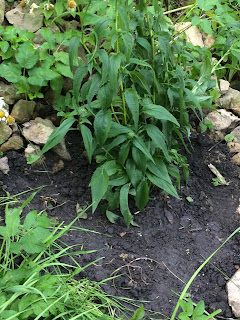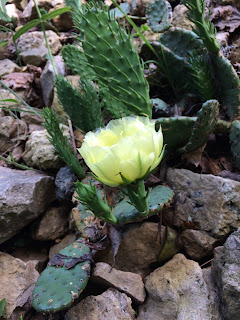Generally, I like summer heat. Yet on Saturday during my mid-morning walk, which included a stop at the bank, I stayed in the shade as much as possible. On returning home I walked along Lake Wingra. I savored the brisk wind off of the lake. This poem by the American poet and novelist Hilda Doolittle, who published as H.D., reflects my feelings as the wind cooled my body.
Heat
H. D. (Hilda
Doolittle) , 1886 - 1961
O wind, rend open the heat,
cut apart the heat,
rend it to tatters.
Fruit cannot drop
through this thick air--
fruit cannot fall into heat
that presses up and blunts
the points of pears
and rounds the grapes.
Cut the heat--
plough through it,
turning it on either side
of your path.
Last Friday's (the 29th) work session with the UW Badger Volunteers was cancelled because of the heat. Fortunately, earlier in the week when Ann and I tended the Gardens temperatures were tolerable. On Thursday morning, I left early to meet Janice, a former colleague. On her way to work, she delivered this Purple Cone flower, along with another bunch and Golden Rod. Thanks Janice.
Janice is an avid gardener. As a volunteer she also tends a prairie off of Atwood Avenue and on the east side of Madison. Lovely prairie that borders vegetable gardens along a bike path. We discussed the challenges of recruiting volunteers. I offered to meet with her at an Atwood Avenue coffee shop to discuss recruitment. She mentioned developing a marketing plan for the east side prairie. Something to consider for Prospect Gardens. My concentrated recruitment efforts starting in March has not substantially increased the number of volunteers.
This is the first year one has bloomed. On Saturday's walk I noticed the delicate bloom was disappearing. Oh the impermanence of beauty and life itself.
I trimmed the Forsythia that was shading the cacti. Sometime in the Fall I may move the cacti to a more sunny and prominent place in the Gardens. Perhaps this will encourage more blooms. John thinks this a good idea and he has recommended it for several years.
Here's a close up of the showy bloom. Like a happy and proud adoptive parent, I made sure Janice saw the bloom before she left for work as well as another neighbor and her three friends who were passing by. Laura B., another volunteer working on a prairie further down the path, stopped as she was biking. We both admired the blooming cactus.
In 2000-01 Laura B.,with some help from her husband and minimal help from another volunteer, planted a prairie west along the Path and near the Beltline, a highway bypass around Madison. She shared how she seeded the Prairie and the challenges of maintaining it. Her husband was initially very involved in developing the Southwest Path.
It was good to visit with an experienced and dedicated restorer of prairies. Laura tends what she calls "the big ditch." A few days later Laura emailed that during weeding the ditch she noticed swamp milkweed, boneset, cord grass, and other
wet-tolerant natives. She added: "This is with no burns and very little maintenance since
it was seeded in 2001-2. It’s rewards like this that keep me coming back." The blooming cactus is one my rewards for coming back to Prospect Gardens.
Redeveloping the bed took time, patience and involved much sweating. Pushing a wheelbarrow full of rock down the path and up the ramp to a temporary location tested my endurance. It's a task that I don't want to do for awhile.
Here's a close up of the newly planted native grasses. As they grow they will fill-in the entire bed. Rocks still cover the adjoining area west of this new bed. Removing these and planting more grasses, perhaps, is in the future, but not this summer. My rock days are over for this season.
To close I share with you four pictures of what is now blooming in Prospect Gardens and another poem. Like the blooming cactus, their return are the rewards for tending the Gardens.
This patch needs to be transplanted and moved up front so more folks can enjoy the splendor of these returning beauties. Another task for the Fall. I will subdivide the bulbs. There will be plenty to share with Dianne, a neighbor near the Gardens.
Here's a Pale Purple Cone.The Gardens have fewer of these compared to the more hearty and deeper colored Purple Cones. The Purple Cones are thriving compared to their pale cousins and I really don't know why. Something to look into during the winter months.
Behind this butterfly house is the marvelous and delicate Queen of the Prairie. This year the Queens are making a come back. Last year a disease or fungus attacked the leaves before the blooms could appear. I cut the plants back rather than spraying.
This patch of Poppy Mallow or Winecups, part of Peg's memorial garden, returned in all its splendor. What a marvelous ground cover that blooms for a long time and what a splashy welcome to all who descend the stairs or enter the ramp to the path on the south side of the Gardens. These are as vibrant as was Peg's spirit.
On this warm evening I end with another poem. Gardening, heat and summer itself are instances of thresholds. This poem is from our church's recent newsletter, The Madison Unitarian, which is devoted to thresholds. It speaks to me about the significance and power of thresholds we experience in life. They are entrances to truth and the crossing process towards truth includes letting go.
Entrance by Rainer Maria Rilkg (trans. Dana
Goia)
Whoever you are: step out of doors tonight,
Out of the room that lets you feel secure.
Infinity is open to your sight.
Whoever you are.
With eyes that have forgotten how to see
From viewing things already too well-known,
Lift up into the dark a huge, black tree
And put it in the heavens: tall, alone.
And you have made the world and all you see.
It ripens like the words still in your mouth.
And when at last you comprehend its truth.
Then close your eyes and gently set it free.










No comments:
Post a Comment